Black Art Matters: Inside Jabari Jefferson’s ‘Sacred Spaces’ Exhibit
‘Sacred Spaces,’ Sacred Stories — How 1 Artist And 1 Museum Are Reclaiming Black History [Exclusive]

A somewhat hidden gem in the DMV-area is Annapolis Maryland, a colonial capital city that sits on the Chesapeake Bay. Just steps away from Maryland’s Governor’s House, the residence of Gov. Wes Moore and first lady Dawn Moore, is the legendary Banneker-Douglass-Tubman Museum. Formerly, Mt. Moriah African Methodist Episcopal Church, the museum now operates as a focal point for Maryland’s Black culture. “What the museum does is highlight individuals that maybe we don’t know of but also have a repository for people to learn more about them,” Banneker-Douglass-Tubman Museum curator of collections and exhibitions Martina Dodd explained.
On an ordinary weekday, you’ll find a handful of visitors at the museum browsing a compelling debut exhibit. DMV native and School of Art Institute of Chicago alum Jabari Jefferson describes his debut Sacred Spaces as history with modern taste. “One of the cool things about that show is it literally was curated specifically for this community,” said Jefferson. Sacred Spaces has been open to the public since February, premiering with a Black History Month celebration and reception. The year-long experience celebrates African American heritage while advocating for sustainability in art. Sacred Spaces features never-before-seen works on canvas along with captivating sculptures. As a mixed media artist, Jefferson uses textiles, books, soil, clothing, and other salvaged materials to create a large-scale community installation for the first time ever in his career.
RELATED CONTENT: Why Are Important Black History Exhibits Being Removed From NMAAHC?
“When I think about Jabari’s future, right? He’s gonna go on to have shows and exhibitions and teach a whole generation of other young artists and he’s gonna be in history books and all the things,” Banneker-Douglass-Tubman Museum executive director Chanel C. Johnson, expressed. “But his first solo museum exhibition is gonna’ be with us, and he’s never gonna forget that [laughs]. So it’s really special that we are pouring into the production of art, the production of Black culture, and the fact that we have the opportunity to keep doing that generationally; it’s really exciting.” At a time when Black art and archival items are vital, MadameNoire got an exclusive behind the scenes look at Jabari Jefferson’s debut exhibition Sacred Spaces.

MadameNoire: What is a sacred space to you? Whether that’s in a literal sense or a figurative sense?
Chanel C. Johnson: “Black museums are sacred spaces because many of the Black museums that we know of, even the more and lesser known [museums] throughout the country, were born out of the Black Power movement. [The museums] are products of the civil rights movement. Civil Rights leaders, activists, educators, and community leaders created these museums because Black history wasn’t centered in the mainstream…They created these small museums in homes and churches…it was a community-led effort. So every time I go to a Black museum, be it the National Museum of African American History and Culture–it was 100 years in the making. When I think about the DuSable Museum, the Studio Museum in Harlem, when I think about our museum, it’s all within this network of just this history of Black resistance.”
Jabari Jefferson: “A sacred space for me is more like a frequency. So I created the environment for other people to be in a frequency…The reason I titled that show that [Sacred Spaces] is because I believe you got to define stuff. If you tell them it’s sacred, then it’s sacred…And that title is so awesome. Like, I literally came up with it, and then at one point I was open to pivot to something else. Martina actually saved it [the title]. I thought that was significant because sometimes you don’t want to go against the current. I’m a big person on friction. Whatever my desire is and it’s going up against something, especially something that’s not within my control, that’s more of a sign. I don’t go against the grain.”

Martina Dodd: “I love the water. So for me anytime I’m sitting on a beach, like with my feet in the sand, hearing the sounds, or wading in the water. To me, that’s sacred. Having the freedom to do whatever you want. But anytime I’m in the Atlantic Ocean I think about my ancestors and the journeys that they took through the water to get here. And honoring them while in that space and thanking them. And then also thinking about ‘okay, what am I gonna do with my life?’ What foundations will I be able to lay for my siblings, my kids, anyone that I interact with? So I guess in the more figurative term of a sacred space is somewhere I can feel free and vulnerable so that then I could be my authentic self and to create something that will live on past myself.”
Do you have a favorite piece in the exhibit in particular?
Chanel C. Johnson: “All of them are amazing. I think the piece that I talk about the most is the piece in our main gallery ‘I want to be an artist when I grow up.’ Representation matters. You know what I mean, for young artists, for young Black boys to see a young Black man have a solo exhibition–coming into his own to acclaim and doing so many great things. I love that piece. Yeah, it’s precious.”
Martina Dodd: “My favorite one might be the legend of general Tubman, the conductor. That’s one of the large works on the third floor of Harriet Tubman. I love that because there’s so much symbolism in that work…I love the idea that Jabari is layering on top of a historic reproduction of Rembrandt…So by painting over this white man’s face and putting a Black formerly enslaved woman on top of that, it’s reversing what has happened to our history for too long. People whitewashing our history [and] people underrecognizing the contributions we’ve given to this country. Jabari recognizes who Harriet Tubman is, in all her glory, a general, a nurse, a spy, a highly intelligent woman. I think that’s one of the reasons why I’m really drawn [to the piece]. I love talking about that work.”
Jabari Jefferson: “For my favorite piece, I don’t know. I really like them all to be honest. They’ve all made me very proud. Each one is successful in its own right and doing what it’s supposed to do. So it’s kind of like, even ones that may be a little quieter, it still did what it was supposed to do [pauses] …the knights templar piece. It’s a piece upstairs in the opposite direction of the steps. It’ll be three figures of these women that are looking directly at you in a staggered design composition. So it’s inspired by Moorish history and Black people in relationship with the Moors, who are Africans that ruled Europe, and they pretty much influenced the whole world. Renaissance culture, capsule culture, cathedrals. That’s why I do the stained glass, because it came from them. So I’ve always had them as a motif in my work.”

What do you want visitors to learn and take away from the exhibit?
Chanel C. Johnson: “…A lot of the tours for our visitors are self-guided, so there’s so much rich conversation around just reading about the work. It’s in dialogue with our collections, museum history, [Jabari’s] genealogy, Maryland history. It’s just so many rich things that you don’t have to go to art school to understand or major in history to understand. It’s very accessible the way it’s being shared so I’m really proud of the show.”
Martina Dodd: “It’s always nice for people to come into this space and go to where they’re drawn to first. This exhibit is about sacred spaces and thinking about within your own personal body ‘what are you drawn to?’ And then from there, you can learn more about the object or the theme through reading the wall tags or talking to the artist or the curator. But I like the idea of someone coming with their own background and perspective and putting that on the meaning of it before someone telling you what it’s supposed to be.”
Jabari Jefferson: “So initially, what I was proposing was I wanted to do a public installation with the whole thing and turn the walls into this mixed media temple. But I then had the insight to break it into pieces, because it was these specific conversations that I wanted to have, and I didn’t want it to just be a cool moment. But with the mindset of a temple, I treated the pieces like, well, ‘if it’s a temple, you got to have relics. You got to have artifacts.’ So I was inspired by if you walk into a religious place or something that has been deemed important or significant or sacred by someone else, it has a feel to it. They have these important objects in it. And that’s how I wanted to treat that place.”

How are you navigating moving forward in terms of arts education, especially now in this political climate?
Chanel C. Johnson: “In our kids program, they’re creating these installations of their sacred space and what a sacred space means to them. But to your point, the way that we’re able to create interpretive programming around the work gives even greater access. Because people can experience the work in new and exciting ways. So we’re excited, and we’re doing a publication. The publication is gonna be really good, really good.”
Jabari Jefferson: “We didn’t know that the next presidential administration would then start to alter Black history and or that Black history would then become [more] significant, because they’re literally eradicating Black history from memorial sites, from the database, which they do every 100 years or so. So it’s up to us to archive our situation. But we didn’t know these things would happen. And I’m very fortunate to have followed my instincts and not give in to the doubt.”
RELATED CONTENT: National Museum of African American History And Culture Launches ‘The Searchable Museum’ To Provide Digital Access To The Black Experience
What’s next for the Banneker-Douglass-Tubman Museum?
Martina Dodd: “We are right now working on the exhibit catalog for this show. I think that the responsibility museums have that maybe is different from a commercial gallery is, not only are we showcasing the work, but we’re also providing scholarship around the work. So with the publication, people are going to be able to see these beautiful images of the work. Then be able to read in depth essays about Jabari’s process and how he collects the material. Also the meaning behind some of the themes of the work. So, I’m really excited to be working on a publication that people can learn more about the history of the museum and the art but [also] have a physical thing to buy and take with them.”
Chanel C. Johnson: “So right now, we’re focused on strategic planning. We’re focused on growing community, growing our resources …We already have the blueprint in our collections, so we’re acting on it. And when I think about the future, I think about how Black history can be preserved in new ways and with new technology… It’s exciting, it’s inspiring.”
Sacred Spaces is now on view at the Banneker-Douglass-Tubman Museum until Dec. 30. The museum’s operating hours are Tuesday-Saturday from 10:00 a.m. – 4:00 p.m. For more information or to schedule a visit, bdtmuseum.maryland.gov.
RELATED CONTENT: Why Are Important Black History Exhibits Being Removed From NMAAHC?







